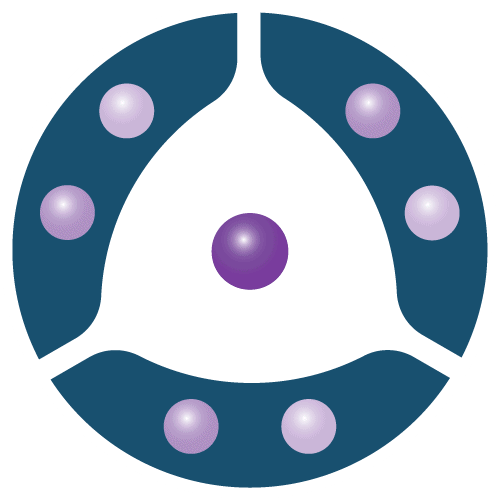Multi-assay High-throughput Drug Repurposing Screen: KCNC1 Case Study
Case Study
Case Study title
Multi-assay High-throughput Drug Repurposing Screen: KCNC1 Case Study
Overview
Introduction: Eliana’s Pathogenic Variant
Eliana is a two-year-old from Canada with a de novo mutation (V434L) in her KCNC1 gene which encodes for the Kv3.1 channel in central nervous system neurons such as cerebellar neurons and GABAergic interneurons. The mutation manifests as a variety of neurological disorders which can include myoclonic epilepsy and ataxia due to K+ channel mutation, developmental epileptic encephalopathy (DEE), or hypotonia, depending on the specific variant.
Although Eliana does not exhibit typical DEE, she suffers from hypotonia, cortical-visual impairment, vertical nystagmus, and global delays. Eliana’s parents founded the KCNC1 Foundation, where 14 different genetic variants from 36 patients have been registered. Of these patients, 25% share the A421V variant, 12.5% share the R320H variant, a few exhibit the V432M variant, and the remaining variants are seen in 1-3 patients.
Together with their partners, the foundation decided to undertake drug repurposing studies to quickly identify safe and cost-effective therapies for Eliana. The KCNC1 Foundation collaborated with Perlara, who approached Metrion Biosciences, where manual and automated (Qube) patch-clamp techniques and Fluorescent Imaging Plate Reader (FLIPR) high throughput screens (HTS) against the mutant channel were performed to identify hit compounds.
Characterising the de novo KCNC1 mutation
At the beginning of the study, it was unknown whether the V434L variant caused a loss-of-function or gain-of-function mutation. The variant was later identified as a gain-of-function mutation by Clatot et al1, where the biophysical properties of the mutant channel were investigated by the patch-clamp technique.
As a first step, Metrion reproduced and confirmed these findings using the manual patch-clamp platform, on HEK293 cells transiently transfected with a plasmid expressing wild type KCNC1 or the V434L variant, as well as in non-transfected cells Figure 1). The findings indicate that mutant channels activate at more negative (hyperpolarising) voltages which confirms a gain-of-function, in comparison with the currents observed in wild type KCNC1.
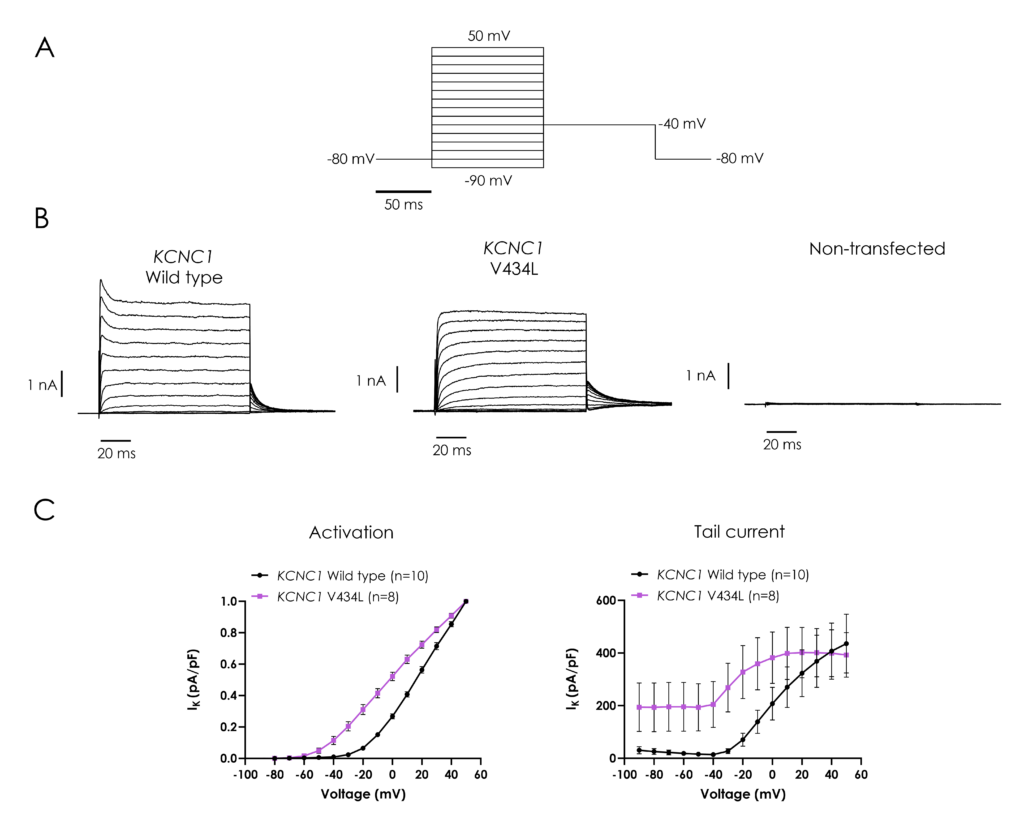
Figure 1
Evaluating the mutant Kv3.1 channel pharmacology
In order to evaluate the pharmacology of the Kv3.1 V434L gain-of-function variant, Metrion transiently transfected Chinese Hamster Ovary (CHO) cells with plasmids expressing either wild type KCNC1 or V434L variant. The effects of two known Kv3.1 channel modulators, 4-aminopyridine (4-AP) and AUT1, on the wild type and V434L currents were assessed by manual patch-clamp recordings. Wild type and V434L currents exhibited different pharmacological profiles using the two modulators tested. At the highest concentration of 4-AP tested (3 mM), wild type KCNC1 currents were almost fully inhibited, whereas V434L KCNC1 currents were only partially inhibited (~40%) at +40mV applied voltage (Figure 2A). AUT1 increased the wild type current size in a concentration-dependent manner, however, inhibited V434L KCNC1 currents at the highest concentration (30 µM) (Figure 2B).
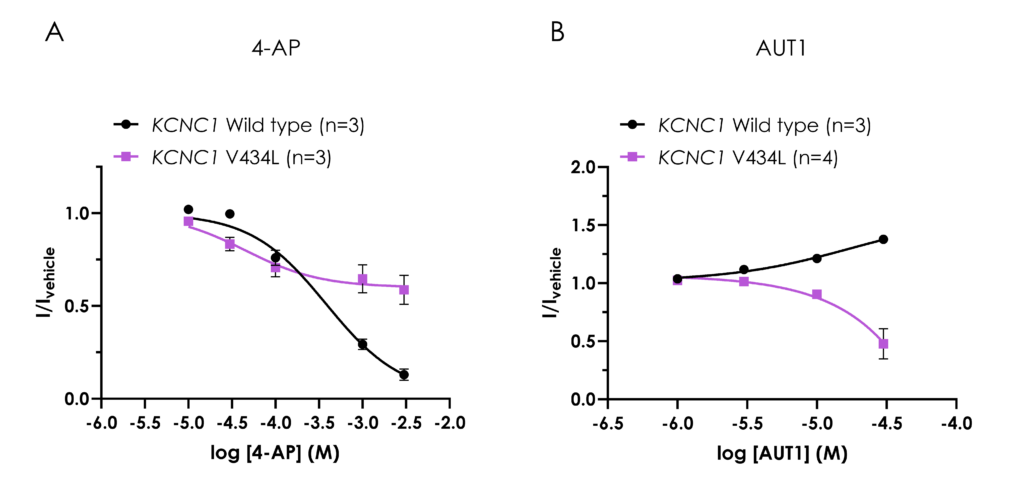
Figure 2
Development of a monoclonal V434L KCNC1 cell line
The differences in pharmacology and the need to improve assay performance reinforced the necessity to generate a monoclonal cell line, suitable for use in the drug repurposing screening phases. Firstly, polyclonal CHO cell lines were produced for WT and V434L KCNC1. A combination of FLIPR thallium flux and Qube assays were used to identify the best clone. Up to 384 monoclones were tested as part of the initial clone screen using the FLIPR thallium assay, and the ten highly expressing putative clones were selected for expansion and re-testing. For each clone, an 8-point concentration-response for 4-AP, AUT1, and TEA-Cl were constructed, along with time-matched controls. Four clones were selected based on their high relative fluorescence units (RFU) and large signals between modulator and control wells. Channel expression in these four clones were evaluated on the Sophion Qube platform, and the clone fulfilling the QC criteria (≥400pA) were identified as the best monoclonal cell line expressing V434L KCNC1 (Clone 2G6) (Figure 3).
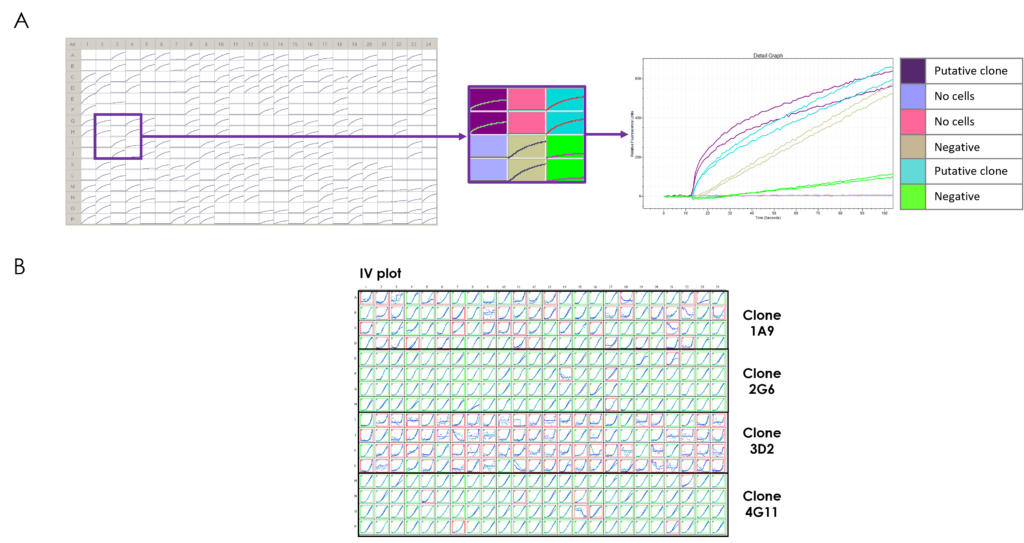
Figure 3
FLIPR Penta assay development and spiked plate assessment
Using the monoclonal cell line expressing V434L KCNC1, Metrion developed a fluorescence assay on the FLIPR Penta platform, designed to identify modulators of the mutant channel. The parameters optimised included cell plating and incubation conditions, buffer composition and extracellular K+ and Tl+ concentrations in stimulus. In order to test whether known modulators can be successfully identified as hits using the assay, a spiked plate assessment was performed whereby a known modulator, AUT1 was spiked across a 384-well plate at various concentrations, in triplicates, in a randomised manner (Figure 4A).
As part of an observational study in Italy, a patient with another KCNC1 variant (V425M) electrophysiologically similar to Eliana’s V434L variant (Ambrosino et al 20232), showed promising improvements with fluoxetine. For this reason, fluoxetine was included in the same spike plate assessment, where randomly scattered data points for AUT1 and fluoxetine were then used to construct concentration-effect curves (Figure 4B and C). Both compounds were shown to be equipotent, and the IC50 values were comparable to those obtained from non-randomized serial dilution.
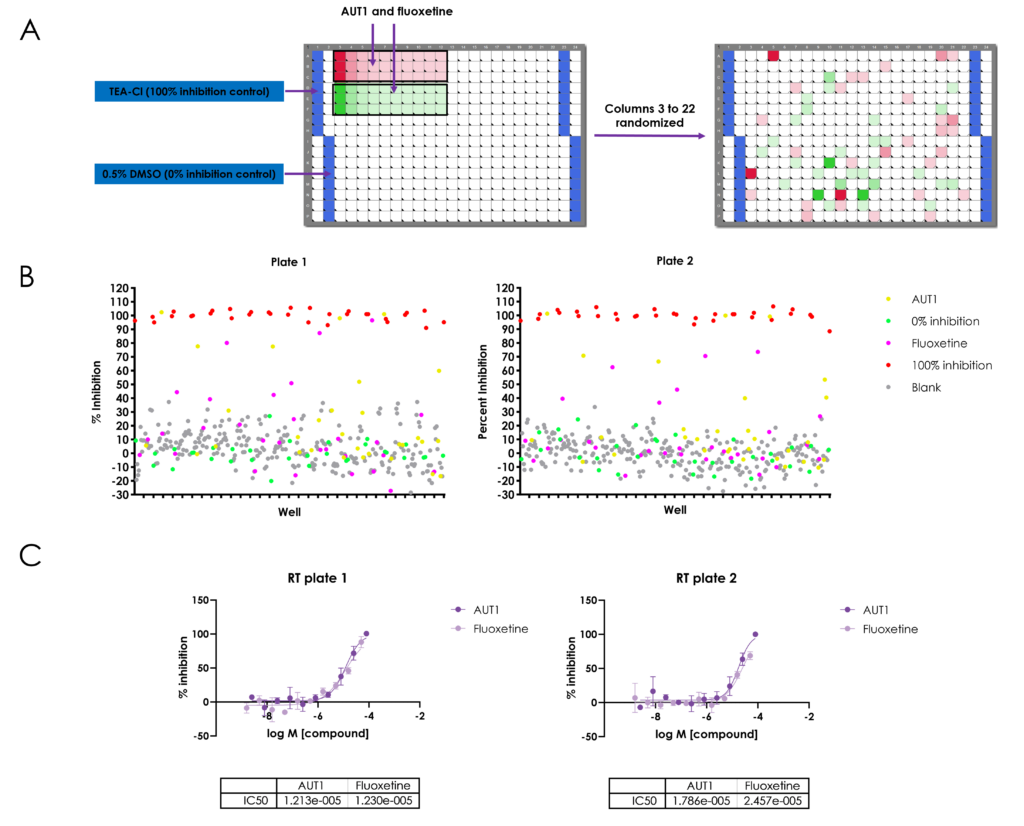
Figure 4
High-throughput repurposing screen / hit-finding exercise using FLIPR assay
In August 2023, Metrion received a replicate pair of compound plates from the Broad Institute. The plates included 6,718 compounds from the Broad Repurposing Hub library which were screened against V434L KCNC1 using thallium flux assay on FLIPR. The percentage inhibition was determined for each test well relative to in-plate controls and the data quality visualised using a combination of scatter plots and heat maps. Using the library annotations provided by the Broad Institute, parameters such as the recorded target class and the stage in drug development were considered for the most active compounds as an example of possible methodologies to triage compounds for further assessment (Figure 5 and 6). Control wells were used to monitor the robustness of the assay and for normalisation purposes to calculate percentage inhibition. Signal-to-background (S:B) and Robust Z’ (RZ’) were calculated, and RZ’ value was used as a primary pass/fail criterion (RZ’>0.5). At a 90% inhibition threshold, 34 test compounds were identified as hits (0.5% hit rate). Fluoxetine and norfluoxetine were also included in the Broad Repurposing Hub library, neither of which were identified as hits against Eliana’s V434L KCNC1 variant. However, an over-the-counter nutraceutical was identified as a top hit which significantly inhibits V434L KCNC1.
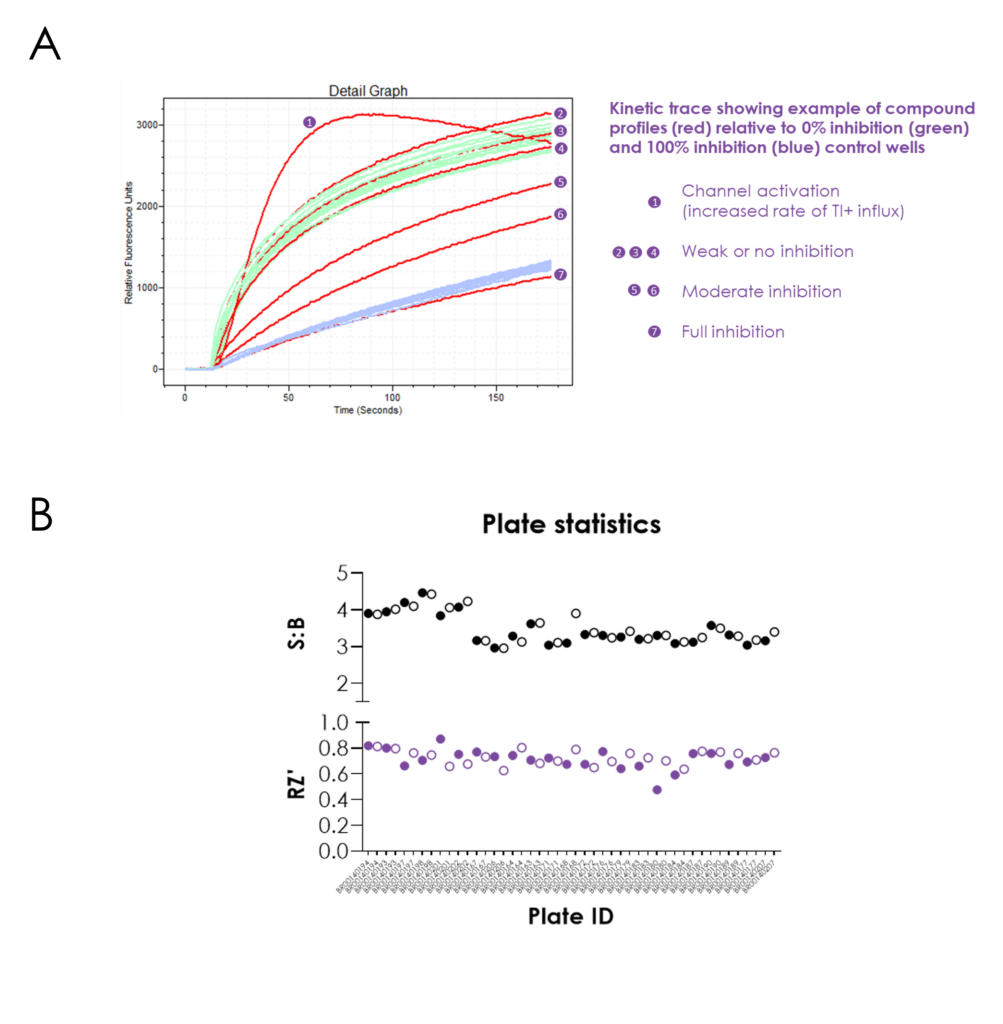
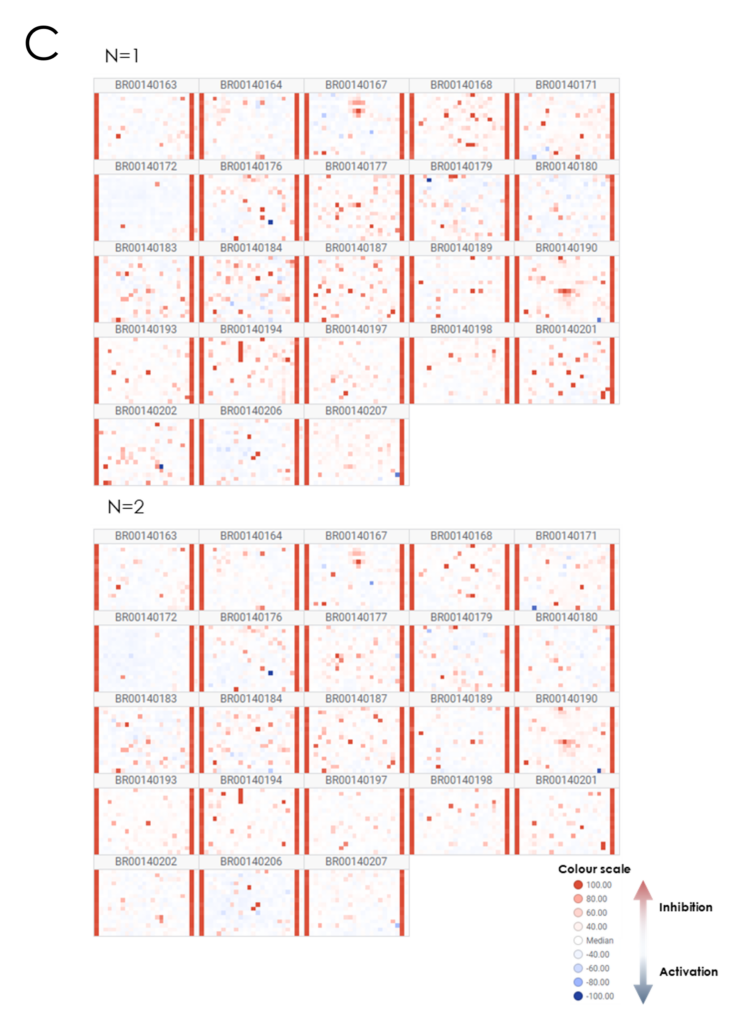
Figure 5
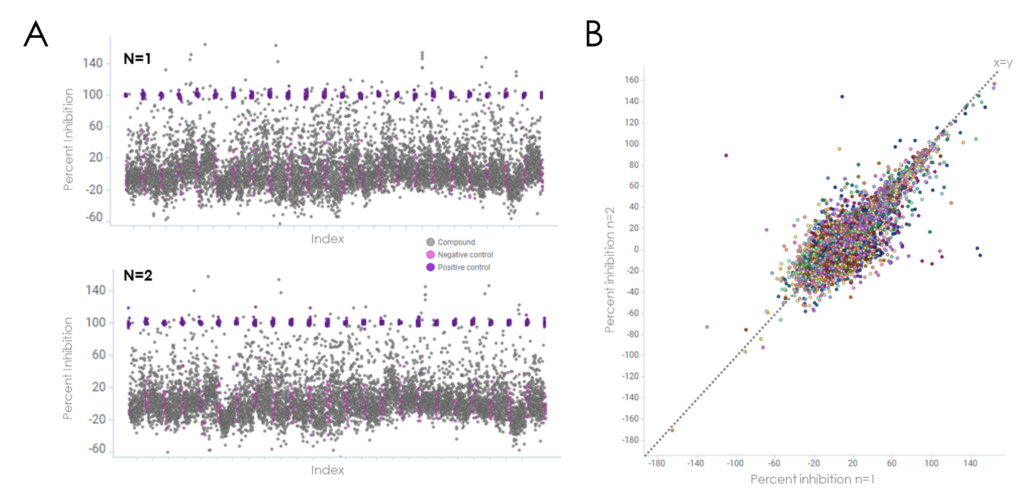
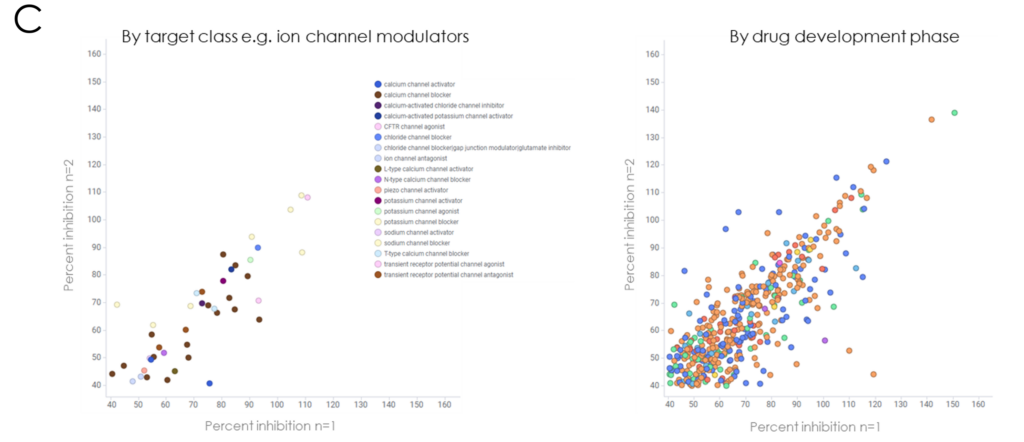
Figure 6
Conclusions
- Metrion Biosciences successfully delivered a high-throughput screening study using multiple assays including manual and automated patch-clamp (Qube) and FLIPR Penta platforms.
- Eliana’s de novo V434L mutation in her KCNC1 gene has been confirmed to be a gain-of-function mutation.
- The V434L KCNC1 currents were exhibited a different pharmacological profile in comparison with wild type currents.
- A monoclonal V434L KCNC1 cell line was generated using a combination of FLIPR thallium flux and Qube assays.
- A FLIPR fluorescence assay was developed, and its sensitivity was validated using a spiked plate assessment.
- A high-throughput repurposing screen was performed using compound plates which included 6,718 compounds from the Broad Institute and an over-the-counter nutraceutical was identified as a promising hit.
- The next and final stage of the study will aim to determine the potency and selectivity of the hit compounds.
References
- Clatot J. et al (2022) A KCNC1-related neurological disorder due to gain of Kv3.1 function. Annals of Clinical and Translational Neurology; 10(1):111-117
- Ambrosino P. et al (2023) A novel KCNC1 gain-of-function variant causing developmental and epileptic encephalopathy: “Precision medicine” approach with fluoxetine. Epilepsia; 64(7): e148-e155.

